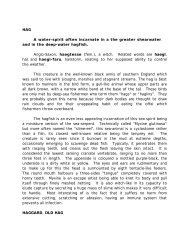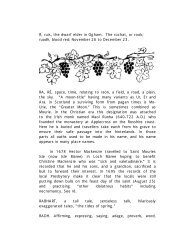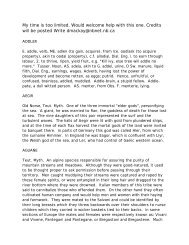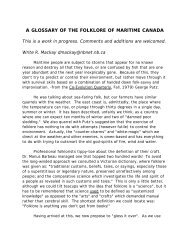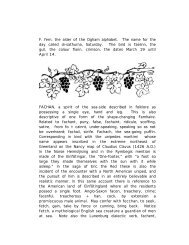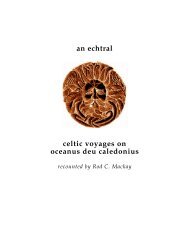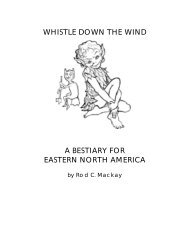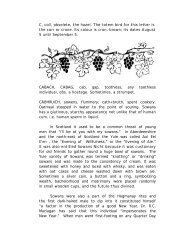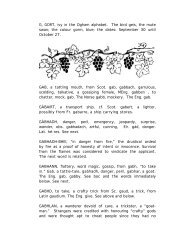L, luis, the mountain ash in the Ogham. Confers ... - Rodney Mackay
L, luis, the mountain ash in the Ogham. Confers ... - Rodney Mackay
L, luis, the mountain ash in the Ogham. Confers ... - Rodney Mackay
You also want an ePaper? Increase the reach of your titles
YUMPU automatically turns print PDFs into web optimized ePapers that Google loves.
Follow<strong>in</strong>g <strong>the</strong> Roman example <strong>the</strong> Picts and <strong>the</strong><br />
Britons came to favour carvel-constructed wooden ships, an<br />
example of which was recently recovered from <strong>the</strong> Thames<br />
River. A planked craft, she was 60 feet long, had a 16 foot<br />
beam, and a mast 10 <strong>in</strong>ches <strong>in</strong> diameter at <strong>the</strong> seat. Her<br />
l<strong>in</strong>es were that of an easy sea-go<strong>in</strong>g craft, not much<br />
<strong>in</strong>ferior to <strong>the</strong> schooners of Atlantic Canada which sailed to<br />
<strong>the</strong> Grand Banks <strong>in</strong> this century. Both types of vessel were<br />
square-masted, powered by oars <strong>in</strong> calm wea<strong>the</strong>r or where<br />
it was necessary to get through a narrow passage.<br />
By <strong>the</strong> sixth and seventh centuries Celtic and Pictish<br />
mar<strong>in</strong>ers became even more common <strong>in</strong> <strong>the</strong> trade with<br />
Norway and France, and it is dur<strong>in</strong>g this time that <strong>the</strong><br />
voyages of St, Brendan were written down. That story<br />
seems a collation of numerous <strong>in</strong>dividual voyages coloured<br />
by folk-memory, never<strong>the</strong>less it is clear that <strong>the</strong>re are<br />
some underly<strong>in</strong>g Atlantic trips remembered <strong>in</strong> it. By this<br />
time <strong>the</strong> Picts were gett<strong>in</strong>g <strong>in</strong>to <strong>the</strong> Baltic, and were firmly<br />
established as residents on <strong>the</strong> islands north of Scotland.<br />
In <strong>the</strong> last quarter of <strong>the</strong> sixth century <strong>the</strong> Picts of<br />
<strong>the</strong> Orkneys became Christianized follow<strong>in</strong>g <strong>the</strong>ir Irish and<br />
Scottish cous<strong>in</strong>s. All <strong>the</strong>se peoples had semi-permanent<br />
fish<strong>in</strong>g stations and monasteries <strong>in</strong> Iceland, and all <strong>the</strong><br />
while <strong>the</strong> climate situation was improv<strong>in</strong>g. The fish<strong>in</strong>g <strong>in</strong><br />
western waters was phenomenal but <strong>the</strong> Celts were never<br />
lack<strong>in</strong>g <strong>in</strong> natural resources at home, and <strong>the</strong>y were not<br />
subject to populations pressures great enough to cause<br />
<strong>the</strong>m to th<strong>in</strong>k of wide-spread resettlement. In all this time<br />
<strong>the</strong> Scand<strong>in</strong>avian peoples were content to trade across <strong>the</strong>ir<br />
<strong>in</strong>land seas and had no true ocean-go<strong>in</strong>g ships.<br />
By <strong>the</strong> seventh century <strong>the</strong> still warm<strong>in</strong>g climate<br />
encouraged agriculture, created a baby-boom and allowed<br />
people <strong>the</strong> time to lust after luxuries. The sight of British<br />
trade ships helped to <strong>in</strong>crease <strong>the</strong> appetite for th<strong>in</strong>gs, so<br />
<strong>the</strong> nor<strong>the</strong>rn men built craft based on Celtic models, and<br />
made <strong>the</strong>ir first “expeditions” to Scotland, Ireland and <strong>the</strong>



